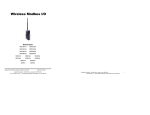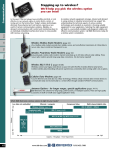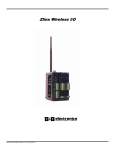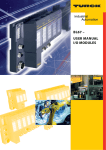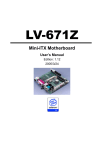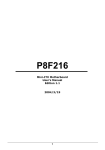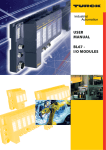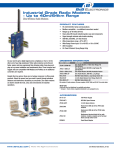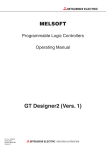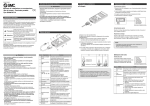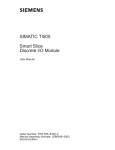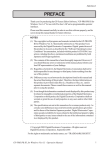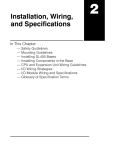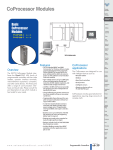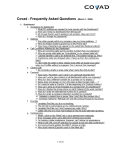Download Zlinx 485 Industrial I/O - Manual
Transcript
Zlinx 485 Manual Documentation Number: Zlinx485m-1808 www.bb-elec.com www.bb-europe.com Zlinx 485 Documentation Number: Zlinx485m-1808 This product was designed and manufactured in Ottawa, Illinois USA Using domestic and imported parts by International Headquarters B&B Electronics Mfg. Co. Inc. 707 Dayton Road Ottawa, IL 61350 USA Phone (815) 433-5100 -- General Fax (815) 433-5105 Website: www.bb-elec.com Sales e-mail: [email protected] -- Fax (815) 433-5109 Technical Support e-mail: [email protected] -- Fax (815) 433-5104 European Headquarters B&B Electronics Ltd. Westlink Commercial Park Oranmore, Co. Galway, Ireland Phone +353 91-792444 -- Fax +353 91-792445 Website: www.bb-europe.com Sales e-mail: [email protected] Technical Support e-mail: [email protected] Revision – Original – April 2008 ©2008 B&B Electronics Mfg Co Inc No part of this publication may be reproduced or transmitted in any form or by any means, electronic or mechanical, including photography, recording, or any information storage and retrieval system without written consent. Information in this manual is subject to change without notice, and does not represent a commitment on the part B&B Electronics Mfg Co Inc. B&B Electronics Mfg Co Inc shall not be liable for incidental or consequential damages resulting from the furnishing, performance, or use of this manual. All brand names used in this manual are the registered trademarks of their respective owners. The use of trademarks or other designations in this publication is for reference purposes only and does not constitute an endorsement by the trademark holder. Manual Documentation Number: Zlinx485m-1808 www.bb-elec.com www.bb-europe.com Introduction Table of Contents Chapter 1: Introduction................................................................................................ 2 About this Manual ...................................................................................................... 2 Support ....................................................................................................................... 2 Zlinx Product Family .................................................................................................. 2 Features ...................................................................................................................... 3 Package Checklist ...................................................................................................... 3 Chapter 2: Hardware .................................................................................................... 3 Zlinx 485 Modules ...................................................................................................... 3 Indicators, Connectors and Accessories ................................................................. 6 I/O Options and Characteristics .............................................................................. 11 Zlinx 485 Modes of Operation ................................................................................. 18 Connecting the Hardware ........................................................................................ 19 Chapter 3: Getting Started .......................................................................................... 21 Zlinx 485 Installation ................................................................................................ 21 Computer System Requirements ............................................................................ 21 Installing Zlinx 485 Software ................................................................................... 21 Connecting Zlinx 485 to a PC .................................................................................. 22 Starting Zlinx 485 Manager ...................................................................................... 22 Chapter 4: Configuration & Operation...................................................................... 26 Configuring Zlinx 485............................................................................................... 26 Peer-to-Peer Mode Settings .................................................................................... 28 Updating Zlinx 485 Firmware .................................................................................. 33 Chapter 5: Modbus Help ............................................................................................ 35 Modbus ASCII/RTU Basics ...................................................................................... 35 Hints and Tips .......................................................................................................... 36 Appendix A: Product Specifications ........................................................................ 37 Appendix B: Dimensional Diagrams......................................................................... 40 Appendix C: Serial Connections ............................................................................... 41 Appendix D: Modbus I/O Assignments .................................................................... 44 Appendix E: Zlinx 485 Models and Features ........................................................... 47 Appendix F: Zlinx 485 Troubleshooting .................................................................... 48 Appendix G: Terms and Definitions .......................................................................... 49 Manual Documentation Number: Zlinx485m-1808 www.bb-elec.com www.bb-europe.com Introduction Chapter 1: Introduction Thank you for purchasing a Zlinx 485 product! This product has been manufactured to the highest standards of quality and performance to ensure your complete satisfaction. About this Manual This manual has been created to assist you in installing, configuring and using your Zlinx 485 Base module. Please read it carefully and follow the instructions to achieve best results. Support For additional information on this and other B&B products, and for technical support, call 815.433.5100 option 3, or access the B&B Electronics website at www.bb-elec.com. Zlinx Product Family Zlinx 485 Base modules provide easy-to-use, cost-effective peer-to-peer or Modbus solutions. Figure 1. A Zlinx ZZ-NX485 Module Manual Documentation Number: Zlinx485m-1808 www.bb-elec.com www.bb-europe.com Introduction The Zlinx 485 family of products features a selection of operational modes, communications modes, Modbus and I/O combinations. The system is scalable making it easy to start with a few I/O points and build a system with the required I/O-Modbus mix. Features • • • • • • • • • • • • • Choice of number and type of digital and analog I/O Supports RS-232 and RS-422/485 lines Sourcing or sinking digital outputs available Configurable NPN (Sinking) and PNP (Sourcing) digital inputs Flexible and scalable by adding expansion modules MODBUS and Peer-to-Peer communications modes Small, economical and configurable Tolerates a wide operating temperature range Choice of a range of DC power sources Power, Data and Bus LED’s Removable screw terminal blocks for power supply and I/O-Modbus connections Zlinx 485 Manager configuration software DIN rail mountable Package Checklist Zlinx 485 Base modules are shipped with the following items included: 9 Zlinx 485 Base module 9 A printed version of the Zlinx 485 Quick Start guide 9 CD-ROM disc with -Zlinx 485 Manager configuration software -Zlinx 485 Firmware Updater -This manual in PDF format -A quick start guide in PDF format 9 6 foot RJ45 male to serial (DB9 female) adapter cable Expansion modules are shipped with the following items included: 9 Zlinx 485 Expansion module 9 A printed version of the Zlinx 485 Quick Start guide Manual Documentation Number: Zlinx485m-1808 www.bb-elec.com www.bb-europe.com Hardware Chapter 2: Hardware Zlinx 485 encompasses a growing family of products including Modbus, Peer-to-Peer, base modules, expansion modules, configuration software and accessories. All modules are built into similar enclosures featuring male local bus plugs and female local bus receptacles on the sides, which allow modules to connect together. Modules are DIN rail mountable and feature removable screw terminal blocks. Zlinx 485 Modules Zlinx 485 systems consist of base modules and expansion modules. Expansion modules are configured using a base module, which also has programming capabilities. The base module is connected to a PC that is running the Zlinx 485 Manager software. Zlinx 485 systems can operate in Modbus or Peer-to-Peer modes. In Modbus mode a Zlinx 485 system exchanges Modbus messages with a Modbus capable base module. In Peer-topeer mode two Zlinx 485 systems are linked in a slave-master connection to provide dependable, direct serial communications. Figure 2. Front View of Zlinx 485 Base and Expansion Modules Manual Documentation Number: Zlinx485m-1808 www.bb-elec.com www.bb-europe.com Hardware Base Modules Each Zlinx 485 system is built around a base module. Base modules provide Modbus, digital and/or analog I/O and communicate with other Zlinx nodes. Figure 3. A Typical Base Module Several different combinations of digital inputs (DI), digital outputs (DO), analog inputs (AI) and analog outputs (AO) are available. For example, the ZZ-NA-485 Base module features a combination of two AI’s, two AO’s, two DI’s and two DO’s in a package. Expansion Modules Up to six expansion modules can be plugged into the base module to add more I/O capabilities in any combination needed. For example, the ZZ-8DO-T Expansion module provides eight additional digital outputs; the ZZ-2AI2AO provides two analog inputs and two analog outputs. Refer to Appendix E for a list of Zlinx 485 models and features. Expansion modules connect to base modules by plugging the modules together, engaging the local bus connectors located on the sides of the boxes. Male plugs on expansion modules plug into female connectors on the side of the base module or other expansion modules, resulting in a horizontal “stack” with the base module on the left and expansion modules extending to the right. Manual Documentation Number: Zlinx485m-1808 www.bb-elec.com www.bb-europe.com Hardware Figure 4. Base and Expansion Modules Connected Together Programming the Base Module using the RS232 connector The base module has a programming feature that can be used to configure that base module as well as expansion modules. The base module connects to the PC for configuration. Connect a PC through the serial port (COM1 to 16) using the provided RJ45 male to serial (DB9 female) cable. Note: A standard RJ45 to serial (DB9) cable will not work, use only the one supplied Figure 5. Connecting a PC and Base Manual Documentation Number: Zlinx485m-1808 www.bb-elec.com www.bb-europe.com Hardware Indicators, Connectors and Accessories LED Indicators Zlinx 485 Base modules have three LED indicators: a Power LED, a Data LED Local Bus Data LED. and a Expansion modules have two LED’s: a Power LED and a Local Bus Data LED Power LED The Power LED illuminates (red) immediately on power up indicating that DC power is present on the power supply terminals. Data LED The Data LED blinks (green) when data is being transmitted or received, either to an expansion module or another base module. When the LED is off no data is being transmitted or received. Bus LED The Bus LED blinks (green) when data is being transmitted or received on the local bus connection. When the LED is off no data is being transmitted or received. Note: If communications is not established within a preset number of retries (default is 10) the Data and Bus LED’s blink alternately to indicate a loss of communications. Connectors Zlinx 485 Base and Expansion modules feature connectors for connecting field I/O wiring and plugging together Zlinx 485 modules (local bus). In addition, Zlinx 485 Base modules include connectors for connecting a power supply and an RJ45 connecter to connect to the PC using the supplied RJ45 to serial cable. Manual Documentation Number: Zlinx485m-1808 www.bb-elec.com www.bb-europe.com Hardware Figure 6. Power Supply Connector The Power Supply connector (base modules only) is a two-position removable terminal block located on the top of the unit. Terminal spacing is 3.5 mm. The terminal block accepts solid and stranded wires from 28 AWG to 16 AWG. Please check polarity marking in Figure 8. Refer to the following section for information on Power Supply Requirements. Expansion modules receive power from the base module via the local bus connector. Local Bus Connectors Local Bus connectors are included on all base and expansion modules. These connectors are dual row, 14 pin (2 mm spacing) connectors. Base modules have only a female connector. Expansion modules have male connectors on one side and female connectors on the other. Modules are plugged together to supply power and facilitate communication between modules. When adding an Expansion module to a Base module the male connector on the expansion module plugs into the female connector on the base module. The second expansion module plugs into the first, and so on, up to a maximum of six expansion modules. Manual Documentation Number: Zlinx485m-1808 www.bb-elec.com www.bb-europe.com Hardware Figure 7. Local Bus Connector Location RS-422/485 and I/O connectors for base and expansion modules are removable (plug in) screw terminal blocks located on the front and top of the unit. Terminal spacing is 3.5 mm. Depending on the specific model, the number of terminals may vary. The maximum is 16 terminals (two 8-terminal blocks) for I/O, with an additional 5 terminals for RS422/485 on the base module. The Serial Port Connector on the Zlinx 485 is an RJ45 female connector (configured as a DCE) device supporting RS-232 serial communications including TD (Pin 3 on the DB9 end), RD (Pin 2) and GND (Pin 5) signal lines. If the Modbus device you are connecting to the Zlinx Base Module is configured as a DTE device you will use a straight-through serial cable. If the Modbus device is configured as a DCE device, use a null modem cable or adapter. Refer to Appendix C for connection pin-outs. RS-422/485 Connector The RS-422/485 connector on the Zlinx Base module is a five position removable terminal block with screw downs. The connector provides screw connections for: • • • • • Terminal 1 – TDA(-) Terminal 2 – TDB(+) Terminal 3 – RDA(-) Terminal 4 – RDB(+) Terminal 5 – GND Manual Documentation Number: Zlinx485m-1808 www.bb-elec.com www.bb-europe.com Hardware Figure 8. Zlinx 485 Base Module RS-422/485 Connector RS-422/485 Four-Wire Mode When the Zlinx Base module is configured to operate in RS-422/485 four-wire mode the receive terminals are connected to the transmit terminals of the Modbus device it is communicating with. Its transmit terminals are connected to the receive terminals of the Modbus device it is communicating with. Figure 9. RS-422/485 Four-Wire Connection RS-422/485 Two-Wire Mode When the Zlinx Base module is configured to operate in RS-485 two-wire mode (RS422/485 switch in the right position) the two-wire RS-485 two-wire communications cable pair is connected to Terminals TDB and TDA. The communications cable ground/shield is connected to GND. Manual Documentation Number: Zlinx485m-1808 www.bb-elec.com www.bb-europe.com Hardware Figure 10. RS-485 Two-Wire Connection No jumpers are required to bridge the transmit and receive lines in two-wire mode. RS-232 Connection Connect to RS-232 using the RJ45 jack on the front Base module, using the supplied RJ45 male to serial (DB9 female) cable. Note: RTS is reserved for use by the configuration software only. Asserting RTS during normal operation will result in a communication failure. Disable RTS if your hardware supports it. Note: A standard RJ45 to serial (DB9) cable will not work, use only the one supplied Power Supply Requirements Zlinx 485 systems can be powered from 10 to 30 VDC power sources. No supply is included since the power rating of the supply will depend on the total power requirements of all modules used in the system. Appendix A contains a listing of power requirements for all Zlinx 485 modules. Mounting Hardware Zlinx 485 modules can be DIN rail mounted. The DIN mounting clip and spring is included on each module. Manual Documentation Number: Zlinx485m-1808 www.bb-elec.com www.bb-europe.com Hardware Figure 11. DIN Clip with Spring on a Zlinx 485 Module I/O Options and Characteristics I/O Options The Zlinx 485 family of products features a variety of input and output options. Base and expansion module options include: • • • • • • • 2 analog inputs, 2 analog outputs, 2 digital inputs and 2 digital outputs (sourcing or sinking driver) 4 digital inputs and 4 digital outputs (sourcing or sinking driver) 8 digital inputs 8 digital outputs (sourcing or sinking driver) o 8 relay output model available 4 analog inputs o RTD Temperature input module available 4 analog outputs 2 analog inputs and 2 analog outputs (Modules continue to be developed with additional features and options.) Refer to Appendix E for a list of available models and options. I/O Types and Characteristics Digital Inputs DI’s can detect the presence of contact closures, transistor switches or on/off DC voltage signals (low or high logic levels). Voltages below 0.8 VDC are interpreted as a low state. Voltages between 4.0 VDC and 48 VDC are interpreted as a high state. DI’s are also programmable to be NPN or PNP Manual Documentation Number: Zlinx485m-1808 www.bb-elec.com www.bb-europe.com Hardware Digital Outputs Digital outputs send on/off signals (low or high logic levels) to drive external devices such as indicators, relay coils or the inputs of other equipment such as PLC’s, SCADA, etc. Modules with digital outputs are available with sourcing or sinking drivers. Sourcing (PNP transistor) drivers provide up to 240 mA per output at output voltages up to 30 VDC to connected loads. Sinking (NPN transistor) drivers can sink up to 40 mA per output at voltages up to 48 VDC. Analog Inputs Analog inputs accept voltage, current signals, or RTD temperature signals. When configured as voltage inputs the full range is 0 to 10 VDC. When configured as current inputs the full range is 0 to 20 mA and the input resistance is 240 ohms. When configured as RTD input the allowable sensor types are PT100, PT1000 for CU10. Analog Outputs Analog outputs produce voltage or current output signals. When configured as voltage outputs the full range is 0 to 10 VDC at 1 mA maximum. When configured as current outputs the full range is 0 to 20 mA with a maximum load resistance of 375 Ω at 20 mA and 10 VDC supply voltage. 0 to 20 mA AI’s and AO’s accommodate standard 4 to 20 mA instrumentation current loop signals. I/O Wiring DI Wiring DI is programmable to be either NPN or PNP. The following diagram shows typical connection wiring for various digital inputs: Manual Documentation Number: Zlinx485m-1808 www.bb-elec.com www.bb-europe.com Hardware Figure 12. Typical Digital Input Wiring for Various Input Devices (ZZ-4DID0-DCT Expansion Module) Note: No external power supply wiring is required for Expansion modules DO Wiring The following diagram shows typical connection wiring for modules featuring sourcing (PNP) drivers: Figure 13. Typical Digital Output Wiring for Sourcing Outputs (ZZ-4DID0-DCT Expansion Module) The following diagram shows typical connection wiring for modules featuring sinking (NPN) drivers: Manual Documentation Number: Zlinx485m-1808 www.bb-elec.com www.bb-europe.com Hardware Figure 14. Typical Digital Output Wiring for Sinking Outputs (ZZ-4DID0-DCT1 Expansion Module) AI Wiring The following diagram shows typical connection wiring for analog inputs: Figure 15. Typical Analog Input Wiring (ZZ9D-NA-MR Base Module) AO Wiring The following diagram shows typical connection wiring for analog outputs: Manual Documentation Number: Zlinx485m-1808 www.bb-elec.com www.bb-europe.com Hardware Figure 16. Typical Analog Output Wiring (ZZ9D-NA-MR Base Module) RTD Wiring The following diagram shows typical connection wiring for RTD inputs. Figure 17. Typical RTD Input Wiring Manual Documentation Number: Zlinx485m-1808 www.bb-elec.com www.bb-europe.com Hardware Figure 18. Relay Wiring The following diagram shows typical connection wiring for Relay outputs. Figure 19. Typical Relay Output Wiring Modbus Mode Configuration The Zlinx 485 Base module can be configured to operate in Modbus Mode. In Modbus mode messages are sent across the physical layer (wiring configuration) from the Zlinx 485 base to the Modbus network. To use Modbus mode successfully, an understanding of the Zlinx 485 memory map assignments is necessary. Modbus function codes supported: Function 1: Read DO Status Function 2: Read DI’s Function 3: Read AO Status Function 4: Read AI’s Function 5: Write Single DO’s Function 6: Write to Single AO Function 15: Write to Multiple DO’s Messages sent between Zlinx 485 and a Modbus node use Modbus memory addresses to specify what type of information is being sent and where it is stored. In the Modbus addressing scheme each type of I/O (DO, DI, AI and AO) is stored in a different section of the memory. Manual Documentation Number: Zlinx485m-1808 www.bb-elec.com www.bb-europe.com Hardware I/O Type DO DI AI AO Figure 20. Modbus Memory Address 00001 to 00112 10001 to 10112 30001 to 30112 40001 to 40112 I/O Memory Areas Table Within these sections, addresses are reserved for all Zlinx 485 modules that may be used. Module Base Expansion 1 Expansion 2 Expansion 3 Expansion 4 Expansion 5 Expansion 6 Figure 21. Memory Range x0001 to x0016 x0017 to x0032 x0033 to x0048 x0049 to x0064 x0065 to x0080 x0081 to x0096 x0097 to x0112 Module I/O Addressing Table The following examples show how the addressing works: Example 1: To turn on the second digital output (DO2) on the Base Module, the Modbus Base Module sends a message placing a logic 1 in memory location 00002. Example 2: To cause expansion module 3 to output a specified voltage on AO1, the Modbus Base Module sends a message to set the register at Modbus address 40049 to the appropriate value. A list of all Modbus address assignments for all Zlinx 485 points is shown in Appendix D. Several important points about this list should be noted: • • • • • • Some addresses are listed but not implemented in current versions of Zlinx 485 hardware. Some addresses are reserved for internal Zlinx 485 use. Some addresses are reserved for future use. 40000 series addresses store Analog Output data AND Frequency Counter data when Digital Inputs are configured for Frequency Counter operation. For each module, the first eight memory locations are assigned to AO data and the next four locations are assigned to Frequency Counter data. If a Modbus device communicating with Zlinx 485 tries to send to or receive from a memory address not implemented by the hardware in use, the Zlinx 485 replies with an exception response. Users cannot span across two memory maps, i.e. from 34 to 50. Manual Documentation Number: Zlinx485m-1808 www.bb-elec.com www.bb-europe.com Hardware • A maximum of 16 points can be displayed at any one time. Appendix D of this manual contains a list of Modbus I/O assignments for the Zlinx 485. Zlinx 485 Modes of Operation Zlinx 485 systems can operate in Peer-to-Peer or Modbus modes. Peer-to-Peer Mode In Peer-to-Peer mode two Zlinx 485 systems provide full serial I/O functionality. In this mode one Base is configured as the master and the other as the slave. (It does not matter which end of the link is the master and which is the slave.) Both Base Modules must be the same model. Analog and digital input signals connected to AI’s and DI’s on one module appear on the corresponding AO’s and DO’s on the other module. Any Expansion modules included in a Peer-to-Peer system must be chosen to be complimentary. For example, if expansion module 1 on one end of the link is a ZZ-4AI (4 analog inputs), expansion module 1 on the other end of the link must be a ZZ-4AO (4 analog outputs. Figure 22. Peer to Peer Mode Modbus Mode In Modbus mode standard Modbus messages can be sent and received between a Modbus Base Module and a Zlinx 485 system. Data written to output addresses in the Zlinx 485 results in signals appearing on its outputs. Signals connected to Zlinx 485 inputs are converted and stored in Modbus input memory locations and then sent across the link as Modbus messages to the Modbus Base Module. Manual Documentation Number: Zlinx485m-1808 www.bb-elec.com www.bb-europe.com Hardware Figure 23. Modbus Mode devices may be PLCs, RTUs, DCSs, or other Modbus devices, with links up to 32 nodes per Modbus network Connecting the Hardware With an RS-232 connection, the Zlinx 485 Base module is connected to a Modbus device via a DB-9M connector and an RS-232 cable. If the connected Modbus device is configured as a DTE device, use a straight-through cable. If the connected Modbus device is configured as a DCE device, use a null modem cable. Always check the interface specifications of the Modbus device to determine whether it is a DTE or DCE before connecting. RS-232 may be connected to a PC using an RS-485 Converter, to allow using Modscan 32 to poll the registers. For RS-422/485 wiring, the Zlinx 485 Base module is connected to the Modbus device via the RS-422/485 terminal block. In RS-422/485 four-wire mode a cable containing two pairs and a ground/shield is used. In RS-485 two-wire mode a cable containing one pair and a ground/shield is used. Power is supplied to the converter via the power supply terminal block. Manual Documentation Number: Zlinx485m-1808 www.bb-elec.com www.bb-europe.com Hardware Figure 24. Zlinx Base Module 2 wire RS-485 Connections Figure 25. Zlinx Base Module 4 wire RS-232 Connections Manual Documentation Number: Zlinx485m-1808 www.bb-elec.com www.bb-europe.com Modbus Basics Chapter 3: Getting Started Zlinx 485 Installation Zlinx 485 Mounting Zlinx 485 modules are DIN rail mountable. Additional ZZ-DIN1 mounting kits can be purchased for replacement. Each kit includes a DIN clip and spring and four spare screws for the Zlinx 485 enclosure. Computer System Requirements The Zlinx 485 Manager software requires the following computer hardware and operating systems: • • A PC with one serial port available between COM1 and COM16 Windows XP (Home or Professional with SP1 and SP2), Windows 2000 (with SP4), Windows 98 (SP1, Second Edition) or Windows ME Installing Zlinx 485 Software To install the Zlinx 485 Manager software: 1. Insert the CD included with your Zlinx 485 product into the CD ROM drive of your PC. 2. The installation should launch automatically. If not: a. Click Start on the Task Bar and select Run b. Type in [CD drive letter]:\setup.exe 3. Follow the prompts to install the software. When installation is complete Zlinx 485 Manager, Zlinx 485 Firmware Updater, and .PDF files containing this manual and the Quick Start guide are accessible from the Windows Start menu. Manual Documentation Number: Zlinx485m-1808 www.bb-elec.com www.bb-europe.com Modbus Basics Connecting Zlinx 485 to a PC 1. With power disconnected, connect the Base Module into the PC. [Shall change this diagram] Figure 26. Connecting a PC and Base Module 2. Connect any required expansion modules to the base module. (The male local bus connector on the first expansion module plugs into the female connector on the base module. The second expansion module plugs into the first, etc.) 3. Connect the PC serial port to the Base Module using the supplied RJ45 male to serial (DB9 female) 6 ft cable. 4. Re-apply power to the Zlinx 485 Base Module. The Power LED should light up. Starting Zlinx 485 Manager 1. From the Windows Start menu, start the Zlinx 485 Manager software. The Zlinx 485 splash window appears briefly, followed by the discovery window. 2. The Connection drop down list defaults to Automatic discovery. The software scans through COM ports looking for Zlinx 485 devices. The scan starts with the most recently used serial port in which a device was found. Manual Documentation Number: Zlinx485m-1808 www.bb-elec.com www.bb-europe.com Modbus Basics Figure 27. Discovery Window During the scan the Progress box displays information about the scanning process. If a device is not found at the most recently successful port it continues to scan through COM ports 1 to 16. The bar graph near the bottom of the window indicates progress. 3. If the device is not found the Progress box displays: The device was not found on any serial port. a. Check the power supply and serial cable connections b. Click the Connect button. The connection process will be repeated and the device should be found. 4. If Automatic connection is not desired, a particular COM port (1 to 16) can be specified: a. Select the COM port number from the Connection drop down list. b. Click the Connect button to initiate the connection process. Clicking the Stop button stops the module discovery process. 5. If the device is found, the Zlinx 485 Manager window opens. Manual Documentation Number: Zlinx485m-1808 www.bb-elec.com www.bb-europe.com Modbus Basics Figure 28. Zlinx 485 Manager The Zlinx 485 Manager window contains: • File and Help menus • Three tabbed panes: Information, Configuration, and Input/Output • A Help sidebar containing information and hints related to the current tab • A graphic display of the base and expansion Modules discovered • A Status bar (at the bottom) showing the COM port and communications parameters (baud rate, parity, data bits, stop bits and flow control) • An Update button used to save configuration parameters to the modules. • An Exit button. Information Tab The Information tab displays a tree structure listing: • Base and expansion modules detected and their model numbers • Firmware version number for each module Manual Documentation Number: Zlinx485m-1808 www.bb-elec.com www.bb-europe.com Modbus Basics • Hardware version number for each module Configuration Tab The Configuration tab contains fields that allow configuration of: • Communications Modes: Peer-to-Peer Master, Peer-to-Peer Slave, Modbus (and related parameters) Input/Output Tab The Input/Output tab contains: • A tree structure listing input and output types for each module • Input and output configuration options Manual Documentation Number: Zlinx485m-1808 www.bb-elec.com www.bb-europe.com Modbus Basics Chapter 4: Configuration & Operation Zlinx 485 Manager software is used to configure Zlinx 485 hardware. Using Zlinx 485 Manager, the system can be configured to operate in Peer-to-Peer or Modbus modes (receiving Modbus commands and data from a Modbus base module). Digital inputs can be configured to operate in Discrete (on/off) or Frequency Counter modes and analog inputs and outputs are configurable for voltage or current loop operation. Configuring Zlinx 485 Zlinx 485 modules can be configured to operate as Modbus nodes or as serial links in Peer-to-Peer mode. Configuring Modbus Mode When the Zlinx 485 receives a Modbus message to write to a discrete output (0xxxx addresses in its memory map), the Zlinx 485 module turns on its corresponding digital output. If a message containing holding register data is received (4xxxx addresses in its memory map), the Zlinx 485 module converts the value to a voltage or current signal on the corresponding analog output. Figure 29. Modbus Mode devices may be PLCs, RTUs, DCSs, or other Modbus devices, with links up to 32 nodes per Modbus network Figure 30. Digital and analog signals applied to the Zlinx 485 Expansion module’s input terminals are converted to Modbus messages to be sent back to the base module. Digital inputs are Manual Documentation Number: Zlinx485m-1808 www.bb-elec.com www.bb-europe.com Modbus Basics stored as 1xxxx (coil) addresses; analog inputs are converted to 12 bit binary values and stored in 3xxxx (input register) addresses. To configure the Zlinx 485 for Modbus mode: 1. Select the Configuration tab. 2. Select the Modbus option button. 3. In the Modbus Address box, type the Modbus address to be used. Modbus address 0 is reserved for master systems that do not support broadcasts. The allowable range of Modbus addresses is from 1 to 247. The default Modbus address is 1. Figure 31. Configuration Tab with Default Values Testing Modbus Mode Operation Using a Modbus base module, a PC and Modbus simulation software (e.g. Modscan) you can test the link and hardware, and investigate the operation of the Zlinx 485. Modscan is a Windows application that simulates a Modbus master node. You can read from and write to memory locations on the Zlinx 485. Modscan is available as a fully functional time-limited demo from www.win-tech.com., and more information on the basics of Modbus is available at www.bb-elec.com. Manual Documentation Number: Zlinx485m-1808 www.bb-elec.com www.bb-europe.com Modbus Basics Peer-to-Peer Mode Settings In Peer-to-Peer mode digital and analog signals can be transferred in both directions across a Zlinx 485 link. For successful communication both base modules must be the same model and all expansion modules must be complimentary (e.g. DI to DO, AI to AO) and arranged in the same order on the Local Bus. One is configured as Peer-to-Peer Master and other is configured as Peer-to-Peer slave. It does not matter which one is configured as master. Additionally, Peer-to-Peer Master address MUST match the Peerto-Peer Slave address (1-255). Peer-to-Peer Master To configure the Zlinx 485 Base module for Peer-to-Peer Master mode: 1. Select the Configuration tab. 2. Select the Peer-to-Peer Master option button. Figure 32. Peer-to-Peer Master Configuration 3. Set the Peer-to-Peer Master address from 1 to 255. Please note the Peer-to-Peer Slave address must also match. 4. The Polling Rate box contains the number of seconds between polls by the master. The default value of 1 second is usually satisfactory. The range of values is 0 to 20 seconds. If the I/O points are not updating properly, try increasing the value. 5. The Retry Count box contains the number of attempts that will be made to communicate with the slave device before the module indicates communication has Manual Documentation Number: Zlinx485m-1808 www.bb-elec.com www.bb-europe.com Modbus Basics been lost. Lost communication is indicated by the Bus LED’s blinking alternately. The default value of 10 is usually satisfactory. The range of values is 10 to 255. Peer-to-Peer Slave To configure the Zlinx 485 Base Module for Peer-to-Peer Slave Mode: 1. Select the Configuration tab. 2. Select the Peer-to-Peer Slave option button... 3. Set the Peer-to-Peer Slave address from 1 to 255. Please note the Peer-to-Peer Master address must also match. Figure 33. Peer-to-Peer Slave Configuration Input/Output Settings Digital inputs and analog inputs/outputs on Zlinx 485 modules are configured from the Input/Output tab of the Zlinx 485 Manager. The first two digital inputs on any module can be configured as Discrete inputs or Frequency Counter inputs. (Any additional digital inputs operate as Discrete inputs only.) Frequency Counter operation is only functional when the Zlinx 485 is set up in Modbus mode. Analog inputs and outputs can be configured for voltage or current loop operation. To configure digital and analog I/O: 1. Select the Input/Output tab. Manual Documentation Number: Zlinx485m-1808 www.bb-elec.com www.bb-europe.com Modbus Basics An input tree appears listing all base and expansion modules in the system and the inputs available on them. Figure 34. Digital Input Configuration 2. Select the Digital Input to be configured. 3. Select Discrete or Frequency Counter (for the first two inputs only). Do NOT exceed 5 kHz for frequency input. Setting the Digital Mode of either of the first two DI’s to Frequency Mode sets both DI’s on that module to the same mode. Do NOT exceed 5 kHz for frequency input. 4. Select the Analog Input to be configured. 5. Select the required Analog Mode (0 to 10 VDC or 0 to 20 mA). Setting the Analog Mode of one AI or AO sets all AI’s and AO’s on that module to the same mode. Manual Documentation Number: Zlinx485m-1808 www.bb-elec.com www.bb-europe.com Modbus Basics Figure 35. Analog Input Configuration 6. Select the Analog Output to be configured. 7. Select the required Analog Mode (0 to 10 VDC or 0 to 20 mA). If RTD module present then, 1. Select the Input/Output tab. Manual Documentation Number: Zlinx485m-1808 www.bb-elec.com www.bb-europe.com Modbus Basics An input tree appears listing all base and expansion modules in the system and the inputs available on them. 2. Select the RTD to be configured. 3. To increase speed, RTD channels may be turned on or off. If nothing is connected to the RTD channel, then uncheck the Channel Enabled option. 4. Select the RTD type as PT100, PT1000, CU10 depending on your RTD type. 5. Select if you have wired a 2, 3, or 4 wire RTD probe to the input module. Setting the Analog Mode of one AI or AO sets all AI’s and AO’s on that module to the same mode. Saving the Configuration When all configuration settings are complete, click the Update button to save them in the Zlinx 485 Base and Expansion modules. 1. The Progress bar at the bottom of the windows shows the progress of the update. 2. The Status bar displays the following text: Manual Documentation Number: Zlinx485m-1808 www.bb-elec.com www.bb-europe.com Modbus Basics Sending module parameters to the base module. 3. When the updating process is complete, the Status bar displays the message: The configuration has been sent successfully. Updating Zlinx 485 Firmware From time to time updated firmware may become available for Zlinx 485 modules (from the B&B Electronics website). When the Zlinx 485 Manager software is installed on your computer the Zlinx 485 Updater software is also installed. This can be used to update the firmware in your Zlinx 485 modules. The following procedure describes the firmware updating process 4. Disconnect power from the base module. 5. Disconnect all modules from external equipment. (The easiest way to disconnect is to unplug all terminal blocks.) 6. Connect expansion modules requiring updates to the base module. (The male local bus connector on the first expansion module plugs into the female connector on the base module. The second expansion module plugs into the first, etc.) 7. Connect the PC serial port (COM 1 to 16) to the base module using the supplied RJ45 (male) to serial (DB9 female) cable. 8. From the Windows Start menu, start the Zlinx 485 Firmware Updater software. 9. The Zlinx 485 Firmware Updater Caution dialog box appears: Figure 36. Firmware Updater Caution Dialog Box 10. Select the COM port from the Connection drop down list. Manual Documentation Number: Zlinx485m-1808 www.bb-elec.com www.bb-europe.com Modbus Basics 11. Click Connect. 12. Re-apply power to the Zlinx 485 Base module. The Power LED should light up. 13. The Zlinx 485 Firmware Updater window opens and displays a list of the base and expansion modules. 14. On the module list, select the base or expansion module to be updated. 15. In the Firmware Image drop down box, select the image file (.hex). 16. Click the Program button to load the firmware into the module. 17. When all updates are complete, click Exit. 18. Before reconnecting the I/O run the Zlinx 485 Manager software and check to ensure all modules are configured properly. 19. When the configuration check is complete: a. Exit the Zlinx 485 Manager program b. Disconnect power from the Base Module c. Reconnect the I/O. 20. Re-connect power to the Base Module. Manual Documentation Number: Zlinx485m-1808 www.bb-elec.com www.bb-europe.com Modbus Basics Chapter 5: Modbus Help Modbus ASCII/RTU Basics The Modbus protocol emerged in the mid-1970s as an early protocol for linking terminals with Modicon PLCs using a master/slave (sometimes called a master/client) relationship. A simple, open, message-based protocol, it caught on quickly and became a defacto standard in the industry. It supports asynchronous point-to-point and multidrop communications and can be used with a variety of serial interfaces (RS-232, RS-422, RS485, modems, etc). The original Modbus specification included two possible transmission modes: ASCII and RTU. Modbus RTU mode is the most common implementation, using binary coding and CRC error-checking. Modbus ASCII messages, though somewhat more readable because they use ASCII characters, is less efficient and uses less effective LRC error checking. ASCII mode uses ASCII characters to begin and end messages whereas RTU uses time gaps (3.5 character times) of silence for framing. The two modes are incompatible so a device configured for ASCII mode cannot communicate with one using RTU. All Modbus communications are initiated by Modbus masters using a polling query/response format. The master can send broadcast messages (using a slave address of 0), which all slaves accept, but do not reply to. More commonly the master polls individual slaves sequentially. In each poll it sends a message containing a device address, followed by a function code, any data that maybe required, and an error check field. The addressed slave responds with a similar message structure. Typically it repeats back its address and the function code, and then sends a field indicating the number of bytes of data it is sending, followed by the data and the error check field. Slave addresses can range from 1 to 247. Function codes include several common ones typically used in all applications, and additional ones that may be implemented in specific cases. Common function codes include: Read Coil Status (01), Read Input Status (02), Read Holding Registers (03) and Read Input Registers (04). When a master sends a message to a slave it expects to receive a valid response within certain length of time. If the slave does not receive the message, or if the slave receives the message but an error is detected, it does not respond. If the slave cannot respond appropriately for some other reason (e.g. it does not recognize the function code), it will return a message containing an exception response. Manual Documentation Number: Zlinx485m-1808 www.bb-elec.com www.bb-europe.com Modbus Basics Hints and Tips A few simple suggestions that may assist you if your system is experiencing problems include: • • • Slowing down the polling rate may be helpful if power cycling doesn’t cure the problem. A common misperception is that every serial network must terminate with a resistor. While this was true of early serial network configurations, it’s typically the wrong answer – call our technical support and verify if you’re an exception, at 815.433.5100 option 3. A sometimes difficult problem is difference in grounding voltage between various network locations. Stray voltage from lightning or other sources may also find its way onto the network. These conditions make isolation necessary in many settings. Manual Documentation Number: Zlinx485m-1808 www.bb-elec.com www.bb-europe.com Product Specifications Appendix A: Product Specifications Base Module Models: Expansion Module Models: Quick Start guide: Manual: CD-ROM disc: Operating Systems supported: Dimensions: Expansion Feature: Power Indicator: ZZ-NA-485, ZZ-NB-485, ZZ-NC-485, ZZ-ND-485 ZZ-4AI, ZZ-4AO, ZZ-2AI2AO, ZZ-8D0-T, ZZ-8D0-T1, ZZ8DDO-R, ZZ-4DI4DO-DCT, ZZ4DI4DO-DCT1, ZZ4RTD1 Paper copy, PDF available on enclosed CD-ROM disc Available on enclosed CD-ROM disc, and on B&B website Zlinx 485 Manager PDF of Zlinx 485 User Manual PDF of Quick Start guide Windows ME/98/2000/XP 1.15 x 3.65 x 5 in (2.92 x 9.27x 12.7 cm) 1 base module and up to 6 expansion modules Red LED Data Indicator: Green LED (blinks with TD or RD data traffic, Off = no data traffic) Bus Indicator: Green LED (blinks with TD or RD bus traffic, Off = no bus traffic) Data Error Indicator: Data & Bus LED’s blink alternately Modbus Connectors: Removable screw terminal (5 position) block, 3.5 mm spacing Serial Connectors Side connector: RF-45 female, RS-232 Top connector: Removable screw terminal block (5) with screw down clamping Interface Lines Supported: Serial Data Rates: I/O Connectors: RS-232 RS-422/485 RDB+, RDA-, TDB+, TDA1200, 2400, 3600, 4800, 9600, 19200, 38400, 57600, 115200, 230400 bps Removable screw terminal (2, 4 or 8 position) block, 3.5 mm spacing Digital Inputs Voltage Range: 0 to 48 VDC Low Voltage (0): 0.8 V maximum High Voltage (1): 4.0 V minimum Pull up Resistor (NPN Input): Pull down Resistor (PNP Input) 130K 10K Manual Documentation Number: Zlinx485m-1808 www.bb-elec.com www.bb-europe.com Product Specifications Frequency Input: Two DI inputs per module software selectable as Frequency Counters, 0 to 5 kHz range (do NOT exceed more than 5kHz) Digital Outputs Voltage Range: Open Source: 10 to 45 VDC (for sourcing outputs), 0 toVDC (for sinking outputs) 40 mA per output Analog Inputs/Outputs Ranges: Resolution: 0 to 10 VDC or 0 to 20 mA 12 bit Input Accuracy: 0.15 % full scale reading typical, 0.2 % max Output Accuracy: 0.15 % full scale reading typical, 0.2 % max AI Load Resistance: AO Max Output Current: AO Max Source Load: Input Protection: Power Supply Voltage Requirements: Power Supply: Base Module Power Connector: 100 Mega ohms when configured for voltage input 250 ohms when configured for current input 1 mA when configured for voltage output 375 ohms at 20 mA and 10V input voltage when configured for current output Over-voltage to 2x max input voltage 10 VDC to 30 VDC Not included Removable screw terminal (2) block, 3.5 mm spacing Relay Outputs Number of Relays: Type: Output Connection: Common Connectin: Ratings: 8 C (normally open and normally closed) 3.5mm removable terminal block (2 per output) 3.5mm removable terminal block (1 per bank of 4 output) 250 VAC @ 8A, 30 VDC @ 5A (maximum per bank of 4 as grouped on the label) RTD Inputs Number of RTD: Wire configuration: Type: Input Connection: Temperature Range: 4 2, 3, and 4 wire PT100*, PT1000*, Cu10** *Optimized for temperature coefficient of 385 **Optimized for temperature coefficient of 427 3.5mm removable terminal block (4 per output) PT100 = -200 to 650 º C PT1000 = -200 to 100 º C Cu10 = -100 to 260 º C Manual Documentation Number: Zlinx485m-1808 www.bb-elec.com www.bb-europe.com Product Specifications Resolution: Accuracy @ 25ºC: 0.1 º C across -40 to 85 º C ±0.5ºC typical Accuracy -40 to 85ºC: ±2.0ºC maximum Power Consumption: ZZ-Nx-485 = 1W ZZ-4AI = 1W ZZ-4AO = 1.1W ZZ-2AI2AO = 1.2W ZZ-8DI-DC = 0.4W ZZ-8DO-T = 15.8W ZZ-8DO-T1 = 1.1W ZZ-8DO-R = 3.2W ZZ-4DI4DO-DCT = 8.1W ZZ-4DI4DO-DCT1 = 1.0W ZZ-4RTD1 = 0.4W Operating Temperature: Storage Temperature: -40 to 80°C (-40 to 176 °F) ZZ-8DO-R -40 to 65ºC (-40 to 149 º F) -40 to 85 °C (-40 to 185 °F) Humidity: 10% to 90% R.H. non-condensing Enclosure Rating: IP30 Mounting: Certifications: Accessories and Replacement Parts: DIN rail mount, 35 mm FCC: Part 15 Class A CISPR (EN55022) Class A EN61000-6-1 Generic Standards for Residential, Commercial & Light Industrial EN61000-4-2 ESD EN61000-4-3 RFI EN61000-4-4 EFT EN61000-4-6 CI ZZ-DIN1 ZZ-TB1 DIN clip and spring for all ZZ products, 4 spare screws for enclosure Removable terminal block for all ZZ modules Manual Documentation Number: Zlinx485m-1808 www.bb-elec.com www.bb-europe.com Dimensional Diagrams Appendix B: Dimensional Diagrams Figure 37. Dimensional Diagram of a Zlinx 485 Base Module Manual Documentation Number: Zlinx485m-1808 www.bb-elec.com www.bb-europe.com Serial Connections Appendix C: Serial Connections RS-232 Pinouts RJ-45F Pin 1 2 3 4 5 6 7 8 Signal RS-232 DCE Signal Ground Signal Ground Receive Data Transmit Data Clear to Send Request to Send Not Used Not used GND GND RD TD CTS RTS ----- ----IN OUT IN OUT ----- Figure 38. RS-232 Connections for RJ45 type plug Note: PIN 4 (RTS) is reserved for the configuration software only. Asserting RTS during normal operation will result in a communication failure. Disable RTS if your hardware supports it RJ45 Male to RS-232 Female Pinout Manual Documentation Number: Zlinx485m-1808 www.bb-elec.com www.bb-europe.com Serial Connections RJ45 male 1 2 3 4 5 6 7 8 DB9 female 5 5 3 2 7 8 9 9 Signal Name Signal Ground Signal Ground Receive Data Transmit Data Clear to Send Request to Send Not Used Not used Direction ----IN OUT IN OUT ----- Figure 39. RJ45 Male to RS232 female adapter cable RS-422/485 4 Wire Pinouts Signal Name Transmit Data (-) Transmit Data (+) Receive Data (-) Receive Data (+) Signal Ground (COM) Figure 40. Label TDA(-) TDB(+) RDA(-) RDB(+) COM Direction Out Out In In --- Terminal 1 2 3 4 5 Zlinx Base Module Terminal Block Pin-out for RS-422/485 Four-Wire Operation Note: 4-Wire Connections must be wired as Mater/Slave. Refer to B&B Electronics RS-485 Application Note. RS-485 2 Wire Pinouts Manual Documentation Number: Zlinx485m-1808 www.bb-elec.com www.bb-europe.com Serial Connections Signal Name DataA (-) DataB (+) Not used Not used Signal Ground (COM) Figure 41. Label TDA(-) TDB(+) RDA(-) RDB(+) COM Direction In/Out In/Out ------- Terminal 1 2 3 4 5 Zlinx 485 Base Module Terminal Block Pin-out for RS-485 Two-Wire Operation Manual Documentation Number: Zlinx485m-1808 www.bb-elec.com www.bb-europe.com Modbus I/O Assignments Appendix D: Modbus I/O Assignments 00001-00112 Discrete Digital Outputs Modbus function codes supported are: Function 1: Read DO Status Function 2: Read DI’s Function 3: Read AO Status Function 4: Read AI’s Function 5: Write to Single DO (firmware v2.0 or higher) Function 6: Write to Single AO Function 15: Write to Multi DO’s Modbus Address 00001 00002 00003 00004 00005 00006 00007 00008 00009 00010 00011 00012 00013 00014 00015 00016 00017 00018 00019 00020 00021 00022 00023 00024 00025 00026 00027 00028 00029 00030 00031 00032 00033 00034 00035 00036 Description Base Digital Output-1 Base Digital Output-2 Base Digital Output-3 Base Digital Output-4 Base Digital Output-5 Base Digital Output-6 Base Digital Output-7 Base Digital Output-8 Base Digital Output-9 Base Digital Output-10 Base Digital Output-11 Base Digital Output-12 Base Digital Output-13 Base Digital Output-14 Base Digital Output-15 Base Digital Output-16 EXP-1 Digital Output-1 EXP-1 Digital Output-2 EXP-1 Digital Output-3 EXP-1 Digital Output-4 EXP-1 Digital Output-5 EXP-1 Digital Output-6 EXP-1 Digital Output-7 EXP-1 Digital Output-8 EXP-1 Digital Output-9 EXP-1 Digital Output-10 EXP-1 Digital Output-11 EXP-1 Digital Output-12 EXP-1 Digital Output-13 EXP-1 Digital Output-14 EXP-1 Digital Output-15 EXP-1 Digital Output-16 EXP-2 Digital Output-1 EXP-2 Digital Output-2 EXP-2 Digital Output-3 EXP-2 Digital Output-4 #Bytes - Count 0-1 0-1 0-1 0-1 0-1 0-1 0-1 0-1 0-1 0-1 0-1 0-1 0-1 0-1 0-1 0-1 0-1 0-1 0-1 0-1 0-1 0-1 0-1 0-1 0-1 0-1 0-1 0-1 0-1 0-1 0-1 0-1 0-1 0-1 0-1 0-1 V Range Refer to Appendix A Refer to Appendix A Refer to Appendix A Refer to Appendix A Refer to Appendix A Refer to Appendix A Refer to Appendix A Refer to Appendix A Refer to Appendix A Refer to Appendix A Refer to Appendix A Refer to Appendix A Refer to Appendix A Refer to Appendix A Refer to Appendix A Refer to Appendix A Refer to Appendix A Refer to Appendix A Refer to Appendix A Refer to Appendix A Refer to Appendix A Refer to Appendix A Refer to Appendix A Refer to Appendix A Refer to Appendix A Refer to Appendix A Refer to Appendix A Refer to Appendix A Refer to Appendix A Refer to Appendix A Refer to Appendix A Refer to Appendix A Refer to Appendix A Refer to Appendix A Refer to Appendix A Refer to Appendix A Manual Documentation Number: Zlinx485m-1808 www.bb-elec.com www.bb-europe.com Modbus I/O Assignments Modbus Address 00037 00038 00039 00040 00041 00042 00043 00044 00045 00046 00047 00048 00049 00050 00051 00052 00053 00054 00055 00056 00057 00058 00059 00060 00061 00062 00063 00064 00065 00066 00067 00068 00069 00070 00071 00072 00073 00074 00075 00076 00077 00078 00079 00080 00081 00082 00083 00084 00085 Description EXP-2 Digital Output-5 EXP-2 Digital Output-6 EXP-2 Digital Output-7 EXP-2 Digital Output-8 EXP-2 Digital Output-9 EXP-2 Digital Output-10 EXP-2 Digital Output-11 EXP-2 Digital Output-12 EXP-2 Digital Output-13 EXP-2 Digital Output-14 EXP-2 Digital Output-15 EXP-2 Digital Output-16 EXP-3 Digital Output-1 EXP-3 Digital Output-2 EXP-3 Digital Output-3 EXP-3 Digital Output-4 EXP-3 Digital Output-5 EXP-3 Digital Output-6 EXP-3 Digital Output-7 EXP-3 Digital Output-8 EXP-3 Digital Output-9 EXP-3 Digital Output-10 EXP-3 Digital Output-11 EXP-3 Digital Output-12 EXP-3 Digital Output-13 EXP-3 Digital Output-14 EXP-3 Digital Output-15 EXP-3 Digital Output-16 EXP-4 Digital Output-1 EXP-4 Digital Output-2 EXP-4 Digital Output-3 EXP-4 Digital Output-4 EXP-4 Digital Output-5 EXP-4 Digital Output-6 EXP-4 Digital Output-7 EXP-4 Digital Output-8 EXP-4 Digital Output-9 EXP-4 Digital Output-10 EXP-4 Digital Output-11 EXP-4 Digital Output-12 EXP-4 Digital Output-13 EXP-4 Digital Output-14 EXP-4 Digital Output-15 EXP-4 Digital Output-16 EXP-5 Digital Output-1 EXP-5 Digital Output-2 EXP-5 Digital Output-3 EXP-5 Digital Output-4 EXP-5 Digital Output-5 #Bytes - Count 0-1 0-1 0-1 0-1 0-1 0-1 0-1 0-1 0-1 0-1 0-1 0-1 0-1 0-1 0-1 0-1 0-1 0-1 0-1 0-1 0-1 0-1 0-1 0-1 0-1 0-1 0-1 0-1 0-1 0-1 0-1 0-1 0-1 0-1 0-1 0-1 0-1 0-1 0-1 0-1 0-1 0-1 0-1 0-1 0-1 0-1 0-1 0-1 0-1 V Range Refer to Appendix A Refer to Appendix A Refer to Appendix A Refer to Appendix A Refer to Appendix A Refer to Appendix A Refer to Appendix A Refer to Appendix A Refer to Appendix A Refer to Appendix A Refer to Appendix A Refer to Appendix A Refer to Appendix A Refer to Appendix A Refer to Appendix A Refer to Appendix A Refer to Appendix A Refer to Appendix A Refer to Appendix A Refer to Appendix A Refer to Appendix A Refer to Appendix A Refer to Appendix A Refer to Appendix A Refer to Appendix A Refer to Appendix A Refer to Appendix A Refer to Appendix A Refer to Appendix A Refer to Appendix A Refer to Appendix A Refer to Appendix A Refer to Appendix A Refer to Appendix A Refer to Appendix A Refer to Appendix A Refer to Appendix A Refer to Appendix A Refer to Appendix A Refer to Appendix A Refer to Appendix A Refer to Appendix A Refer to Appendix A Refer to Appendix A Refer to Appendix A Refer to Appendix A Refer to Appendix A Refer to Appendix A Refer to Appendix A Manual Documentation Number: Zlinx485m-1808 www.bb-elec.com www.bb-europe.com Modbus I/O Assignments Modbus Address 00086 00087 00088 00089 00090 00091 00092 00093 00094 00095 00096 00097 00098 00099 00100 00101 00102 00103 00104 00105 00106 00107 00108 00109 00110 00111 00112 Description EXP-5 Digital Output-6 EXP-5 Digital Output-7 EXP-5 Digital Output-8 EXP-5 Digital Output-9 EXP-5 Digital Output-10 EXP-5 Digital Output-11 EXP-5 Digital Output-12 EXP-5 Digital Output-13 EXP-5 Digital Output-14 EXP-5 Digital Output-15 EXP-5 Digital Output-16 EXP-6 Digital Output-1 EXP-6 Digital Output-2 EXP-6 Digital Output-3 EXP-6 Digital Output-4 EXP-6 Digital Output-5 EXP-6 Digital Output-6 EXP-6 Digital Output-7 EXP-6 Digital Output-8 EXP-6 Digital Output-9 EXP-6 Digital Output-10 EXP-6 Digital Output-11 EXP-6 Digital Output-12 EXP-6 Digital Output-13 EXP-6 Digital Output-14 EXP-6 Digital Output-15 EXP-6 Digital Output-16 #Bytes 1 - Count 0-1 0-1 0-1 0-1 0-1 0-1 0-1 0-1 0-1 0-1 0-1 0-1 0-1 0-1 0-1 0-1 0-1 0-1 0-1 0-1 0-1 0-1 0-1 0-1 0-1 0-1 0-1 V Range Refer to Appendix A Refer to Appendix A Refer to Appendix A Refer to Appendix A Refer to Appendix A Refer to Appendix A Refer to Appendix A Refer to Appendix A Refer to Appendix A Refer to Appendix A Refer to Appendix A Refer to Appendix A Refer to Appendix A Refer to Appendix A Refer to Appendix A Refer to Appendix A Refer to Appendix A Refer to Appendix A Refer to Appendix A Refer to Appendix A Refer to Appendix A Refer to Appendix A Refer to Appendix A Refer to Appendix A Refer to Appendix A Refer to Appendix A Refer to Appendix A Manual Documentation Number: Zlinx485m-1808 www.bb-elec.com www.bb-europe.com Zlinx 485 Models and Features Appendix E: Zlinx 485 Models and Features Zlinx 485 Base Modules Model Number Module Type Protocols I/O ZZNA-485 Base Modbus, Digital I/O, Analog I/O RS-422/485, RS-232, 2DI, 2DO, 2AI, 2AO sourcing DO’s ZZ-NB-485 Base Modbus, Digital I/O, Analog I/O RS-422/485, RS-232, 4DI, 4DO sourcing DO’s ZZ-NC-485 Base Modbus, Digital I/O, Analog I/O RS-422/485, RS-232, 2DI, 2DO, 2AI, 2AO sinking DO’s ZZ-ND-485 Base Modbus, Digital I/O, Analog I/O RS-422/485, RS-232, 4DI, 4DO sinking DO’s Expansion Modules Model Number Type I/O I/O Types ZZ-4AI Analog Input Module 4AI mA, V ZZ-4AO Analog Output Module 4AO mA, V ZZ-2AI2AO Analog Input/Output Module 2AI, 2AO mA, V ZZ-8DI-DC Digital Input Module 8DI Pull-up, R ZZ-8DO-T Digital Output Module 8DO sourcing ZZ-8DO-T1 Digital Output Module 8DO sinking ZZ-4DI4DO-DCT Digital Input/Output Module 4DI, 4DO sourcing ZZ-4DI4DO-DCT1 Digital Input/Output Module 4DI, 4DO sinking ZZ-8DO-R Digital Output Module 8DO relays ZZ-4RTD1 Analog Input Module 4AI RTD Accessories Model Number Description ZZ-TB1 Removable terminal block replacement kit ZZ-DIN1 DIN rail mounting kit Manual Documentation Number: Zlinx485m-1808 www.bb-elec.com www.bb-europe.com Zlinx 485 Troubleshooting Appendix F: Zlinx 485 Troubleshooting Problem Data LED and Bus LED intermittently blink Causes • Firmware does not match The firmware for all base modules must match and the firmware for all expansion modules must match. The firmware rev number may be viewed on the information tab of the configuration software. If the firmware does not match, then update the firmware with the Firmware Updater Program. • No Peer-Peer communication link The serial connection is not established. Verify that all parameters in the configuration tab in the programming software are correct. • Too many expansion modules installed Only 6 expansion modules may be connected to any base module. • Expansion modules in peer-peer mode do not match In peer-peer mode, the master and slave must have the same number of expansion modules. • Expansion module added/removed without cycling power on base module The Zlinx 485 configures the base module and expansion modules on a cycle of power. No damage occurs by adding/removing a module “hot.” Power will need to be cycled for the base module to update the expansion locations. Manual Documentation Number: Zlinx485m-1808 www.bb-elec.com www.bb-europe.com Terms and Definitions Appendix G: Terms and Definitions Term Definition Base module Master node with I/O Expansion module Expansion node that responds to master node Local bus header/plug B&B proprietary RS-485 bus interconnection via 14 pin 2 mm connector Manual Documentation Number: Zlinx485m-1808 www.bb-elec.com www.bb-europe.com




















































